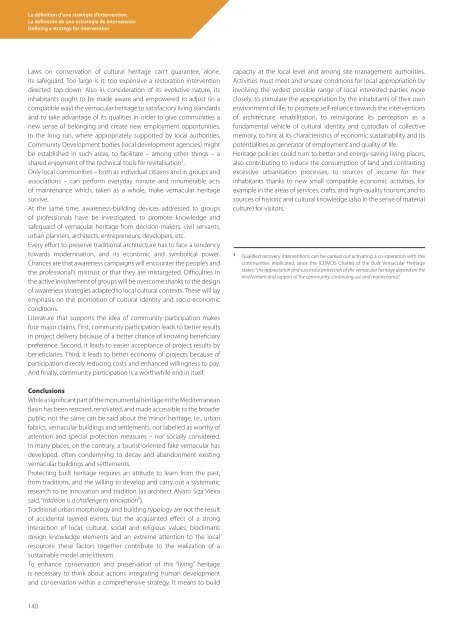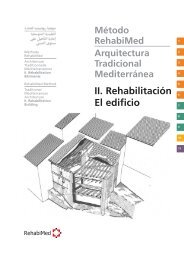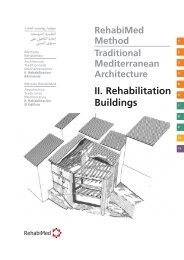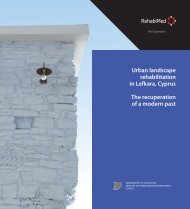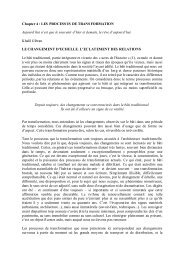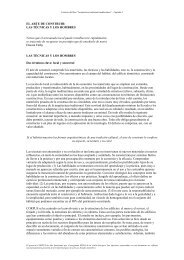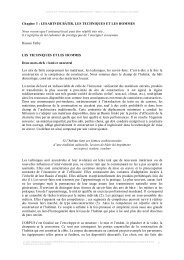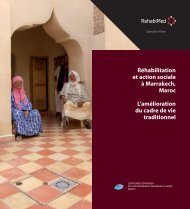La définition d'une stratégie d'intervention. La ... - RehabiMed
La définition d'une stratégie d'intervention. La ... - RehabiMed
La définition d'une stratégie d'intervention. La ... - RehabiMed
Create successful ePaper yourself
Turn your PDF publications into a flip-book with our unique Google optimized e-Paper software.
<strong>La</strong> <strong>définition</strong> d’une <strong>stratégie</strong> d’intervention.<br />
<strong>La</strong> definición de una estrategia de intervención<br />
Defining a strategy for intervention<br />
<strong>La</strong>ws on conservation of cultural heritage can’t guarantee, alone,<br />
its safeguard. Too large is it; too expensive a restoration intervention<br />
directed top-down. Also in consideration of its evolutive nature, its<br />
inhabitants ought to be made aware and empowered to adjust (in a<br />
compatible way) the vernacular heritage to satisfactory living standards<br />
and to take advantage of its qualities in order to give communities a<br />
new sense of belonging and create new employment opportunities.<br />
In the long run, where appropriately supported by local authorities,<br />
Community Development bodies (local development agencies) might<br />
be established in such areas, to facilitate – among other things – a<br />
shared enjoyment of the technical tools for revitalisation 1 .<br />
Only local communities – both as individual citizens and in groups and<br />
associations – can perform everyday minute and innumerable acts<br />
of maintenance which, taken as a whole, make vernacular heritage<br />
survive.<br />
At the same time, awareness-building devices addressed to groups<br />
of professionals have be investigated, to promote knowledge and<br />
safeguard of vernacular heritage from decision-makers, civil servants,<br />
urban planners, architects, entrepreneurs, developers, etc.<br />
Every effort to preserve traditional architecture has to face a tendency<br />
towards modernisation, and its economic and symbolical power.<br />
Chances are that awareness campaigns will encounter the people’s and<br />
the professional’s mistrust or that they are mistargeted. Difficulties in<br />
the active involvement of groups will be overcome thanks to the design<br />
of awareness strategies adapted to local cultural contexts. These will lay<br />
emphasis on the promotion of cultural identity and socio-economic<br />
conditions.<br />
Literature that supports the idea of community participation makes<br />
four major claims. First, community participation leads to better results<br />
in project delivery because of a better chance of knowing beneficiary<br />
preference. Second, it leads to easier acceptance of project results by<br />
beneficiaries. Third, it leads to better economy of projects because of<br />
participation directly reducing costs and enhanced willingness to pay.<br />
And finally, community participation is a worthwhile end in itself.<br />
capacity at the local level and among site management authorities.<br />
Activities must meet and ensure conditions for local appropriation by<br />
involving the widest possible range of local interested parties more<br />
closely, to stimulate the appropriation by the inhabitants of their own<br />
environment of life, to promote self-reliance towards the interventions<br />
of architecture rehabilitation, to reinvigorate its perception as a<br />
fundamental vehicle of cultural identity and custodian of collective<br />
memory, to hint at its characteristics of economic sustainability and its<br />
potentialities as generator of employment and quality of life.<br />
Heritage policies could turn to better and energy-saving living places,<br />
also contributing to reduce the consumption of land and contrasting<br />
excessive urbanisation processes; to sources of income for their<br />
inhabitants thanks to new small compatible economic activities, for<br />
example in the areas of services, crafts, and high-quality tourism; and to<br />
sources of historic and cultural knowledge (also in the sense of material<br />
culture) for visitors.<br />
1 Qualified recovery interventions can be carried out activating a co-operation with the<br />
communities implicated, since the ICOMOS Charter of the Built Vernacular Heritage<br />
states: “the appreciation and successful protection of the vernacular heritage depend on the<br />
”.<br />
Conclusions<br />
While a significant part of the monumental heritage in the Mediterranean<br />
Basin has been restored, renovated, and made accessible to the broader<br />
public, not the same can be said about the ‘minor’ heritage, i.e., urban<br />
fabrics, vernacular buildings and settlements, not labelled as worthy of<br />
attention and special protection measures – nor socially considered.<br />
In many places, on the contrary, a ‘tourist-oriented’ fake vernacular has<br />
developed, often condemning to decay and abandonment existing<br />
vernacular buildings and settlements.<br />
Protecting built heritage requires an attitude to learn from the past,<br />
from traditions, and the willing to develop and carry out a systematic<br />
research to tie innovation and tradition (as architect Alvaro Siza Vieira<br />
said, “tradition is a challenge to innovation”).<br />
Traditional urban morphology and building typology are not the result<br />
of accidental layered events, but the acquainted effect of a strong<br />
interaction of local, cultural, social and religious values, bioclimatic<br />
design knowledge elements and an extreme attention to the local<br />
resources: these factors together contribute to the realization of a<br />
sustainable model ante litteram.<br />
To enhance conservation and preservation of this “living” heritage<br />
is necessary to think about actions integrating human development<br />
and conservation within a comprehensive strategy. It means to build<br />
140


